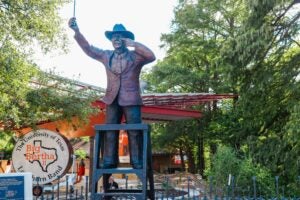We measure our days in slices of time.
Eighty-some years to live a life.
Thirty minutes to drive to work.
An Internet search on the word “time” takes 0.21 seconds to return six million results.
The University of Texas at Austin Tower clock reminds us when every 15 minutes has passed.
But Nature works on its own clock.
Over a billion and a half years mountain ranges the size of the Himalayas rise and fall.
Interactions between light and matter occur in fractions of a second, as do the genetic processes that lead to long-term evolutionary changes.
And completely human endeavors have their own clocks. A new business has a certain time to make it or close shop.
We talked to several researchers at The University of Texas at Austin to see how they deal with the time scales in which they work, from the very long to the very short and in between.
Here’s what they said:
Sharon Mosher
Dean, Jackson School of Geosciences

Mosher explains what she does as a geologist:
“I’m a structural geologist and I tackle tectonic problems,” she says. “I study everything from recent — and my definition of recent is probably not yours — to plate boundaries that are 1.2 billion years old.”
For her, “recent” means five to 10 million years ago.
But, she adds, 1.2 billion years ago is young in the total age of the Earth.
“We go back to having records of events that are 4.5 billion years old on Earth,” Mosher says. “I took a group of 16 students to western Australia once and it was eye opening for me because all of the rocks we saw were older than two billion years old.”
Mosher wanted to be a geologist since she was five years old and the concept of geologic time became natural to her.
“I never found it that difficult,” she says, “maybe it’s because from an early age I taught myself geology and so I got used to the idea.”
She says a geologist does think about time differently.
When a geologist talks about climate change or the extinction of species, those are things that have occurred over and over in Earth’s history over periods of time, she says.
“We’re used to the idea that those things happen and you really have to watch geologists, you have to say, ‘OK, but what about in a human time frame?’ Because very commonly you’ll get an answer and the people listening are thinking in a human time frame whereas the geologist is thinking millions of years. It is different. It really is.”
OK, geologists get geologic time because that’s what they deal with everyday. How do they teach it to beginning geology students?
“It’s actually somewhat difficult,” Mosher says.
“One of the things we do in introductory classes is we have a timeline. In my case, it was a string with orange flags on it,” she says. “You’d get in a big auditorium and you have students come down. One would hold one end and every place there was an orange flag they’d hold and you’d have them start and each one would read their flag.
They’d see that it was quite a while before life planted its flag on the planet.
“What they find is that three-fourths of the auditorium is covered by string before they hit something where there was life with hard body parts such as shells, vertebrates and others,” she says. “Then they’re all crowded together at the end because all these things they’re used to thinking about are all at the very end.”
Aaron Bernstein
Laser Physicist
Associate Director, Texas Center for High Intensity Laser Science

In explaining the time scales involved in his research, Bernstein likes to make analogies that sound like questions on the verbal part of the Scholastic Aptitude Test (SAT).
Bernstein works with lasers that blast pulses of light of durations so short they are measured in femtoseconds, which are one quadrillionth, or one millionth of one billionth of a second.
“It’s kind of hard to get across how short these time scales are,” Bernstein says. “We’ll say that one femtosecond is to a second what three minutes is to the age of the Earth.”
“That sort of boggles their minds,” he says.
Bernstein appreciates how hard such concepts can be to grasp. And he savors the ironies involved.
“It’s not much more than a hundred years since strobe or rapid photography had to be used to detect whether or a not a horse’s hooves all left the ground during running,” he said. “It’s only a hundred years since that kind of technology. Now we’ve got basically a strobe light that is so fast that we can resolve what is happening in molecular interactions. So that’s pretty cool.”
When the laser strikes a material, it creates extreme states of matter that occur in the centers of stars and planets. On Earth, that can be done only microscopically and for a short period.
“But we’re able to extrapolate from such experiments what happens within stars,” he says. “The short pulses allow us to reproduce those kinds of events in short amount of times. But I think it’s ironic that we can study things that occur on a cosmic time scale, locally, with these tools.”
Mark Kirkpatrick
Population Geneticist

Mark Kirkpatrick, an evolutionary biologist, measures time in generations and he studies why evolutionary time scales are different for different creatures.
Some, like the HIV virus that causes AIDS, evolve “superfast,” Kirkpatrick says. HIV’s ability to quickly adapt to its host is one of the reasons it’s so insidious.
The horseshoe crab is an example of a slow evolver.
Kirkpatrick pulls the shell of a crab off a filing cabinet in his office for a closer look. The shell, which he found on a New England beach, is hard and smooth.
Two species of horseshoe crab exist today and they are almost indistinguishable from the horseshoe crabs that lived 300 million years ago, he says.
“We’re trying to get some understanding of why it is that HIV changes rapidly over the course of a dozen generations and horseshoe crabs change hardly at all over hundreds of millions of generations,” Kirkpatrick says. “When talking about rates of morphological evolution or molecular evolution there’s a huge variation in how fast things go.”
Charles Darwin thought that evolution was a slow process that could not be observed.
“What we know is now is that you can actually go out and see this process happening in real time in natural populations,” Kirkpatrick says. “So you can go into a population of HIV viruses or birds or even people and see genetic differences from one generation to the next. You string together several generations and you see a moderate to substantial degree of change.”
Kirkpatrick uses computer models to simulate evolution and genetic changes as a species goes through generations.
He says that by using computational methods for analyzing genetic data, scientists have shown that natural selection often acts on combinations of traits, rather than a single trait in isolation.
“What that suggests,” he says, “is that perhaps one reason that many organisms don’t evolve rapidly is that even though natural selection is favoring a change, the species does not evolve because the right combination of genes is not present.”
Rob Adams
Director, Venture Labs Investment Competition (formally MOOT Corp)
Lecturer, McCombs School of Business

Business moves at an accelerated human time scale when you’re trying to get a business off the ground.
“When you’re in a technology-oriented startup the world moves at a blinding pace because no one’s idea is truly unique,” says Adams, who works with startups and Master of Business Administration (MBA) students who might have a startup in their future.
When starting a company, he says, it’s better to get a product out to customers quickly rather than tweak it here and there to make it perfect. It’s been the norm in the technology industry to improve quality in subsequent releases.
“When it’s technology stuff, it’s just a stomp-your-foot-on-the-gas-and-hang-on-for-the-ride kind of thing,” he says. “And then you’re making mid-course corrections. So your biggest threat when doing this is a competitor catching up with you; and there’s a lot of competition out there.”
He says it’s better to consider the information you have and move quickly rather than wait for a more complete picture before taking a step.
“You’ve got to assemble what little data you have,” he says. “Sometimes you have to extrapolate from a few data points what you think the answer should be. Then you find out in the market whether you made it or not.”
But before rushing out, Adams says entrepreneurs should get a good idea if there is a market for their products.
“Validate the market,” he says. “Too many people raise a bunch of money and start building what they think the market wants and they’re usually wrong.”
His advice is to call 100 people in the target audience and see what they need and how your product fits. Then narrow the focus.
“Find the three features that matter to 30 percent of them and then get those three features in and target that 30 percent,” he says.
Selling a new product with many features takes too long and costs too much money.
“If you solve people’s problems,” he says. “They will give you money. They might be upset with you, and they might not like the quality of the product but if you’re really fixing a market pain, they’ll pay you.”
Adams says it’s easier to get this message across to MBA students in the classroom than entrepreneurs in their garages.
“The graduate student is so busy going to school they’re typically not working nights and weekends on their idea so they’ll listen to everything,” he says. “They’re not getting ahead of where you are. You have more time to reinforce the message.”
More time? What a concept.
Volker Bromm
Astrophysicist

Volker Bromm’s astrophysics research takes him 13.5 billion years back, almost to the beginning of the universe. He comes close, but not quite all the way there.
He’s working on how the first stars formed several hundreds of millions of years after the Big Bang, when gravity for the first time was able to condense the primordial hydrogen and helium made in the Big Bang into structures of extremely high density.
Some of those gaseous interactions occur in fractions of seconds.
Billions, millions, fractions of a second. When it comes to time scales, Bromm covers it all.
“We have the longest possible time scales — meaning the age of the universe is in play,” he says, “and we have the shortest time scales that come from atomic physics, nuclear physics and particle physics. It’s all in astrophysics.”
Getting one’s mind around such a wide spread is not a snap.
“It takes time, literally,” Bromm says with a laugh. “It takes a while to really develop an intuition and think about the hierarchy of time scales you are dealing with and at some point it really only comes with experience.”
He got a handle on it toward the end of his Ph.D. studies at Yale University.
This understanding is essential for an astrophysicist studying things that happened in remote places, billions of years ago, in deciding what effects to consider.
If a process takes a billion years, it can be ruled out as something that affected the first stars, since they already appeared after a few hundred million years, Bromm says.
A fast, efficient process that takes just a million or so years is worth looking at, he says.
“For example, to convert one of these first stars into energetic supernova explosions and then create very, very energetic events that happen on the time scale of say a million years,” he says. “Of course you can say a million years is short compared to the age of the universe so this will likely happen and might be observable with future telescopes.”
Bromm’s scientific instrument is a supercomputer at the Texas Advanced Computing Center rather than a telescope.
“The beautiful thing about the supercomputers is that they can process these very different time scales,” he says.
In some quieter moments, Bromm appreciates the relation of the time scales of the universe to those of the human life.
“It’s unbelievably humbling to think that in astronomy I’d be studying the age of the universe, things that have existed for such long times, and then we write and contemplate for our own very fleeting existence,” he says. “Of course it is very humbling but also provides you with a very interesting point of view.”



